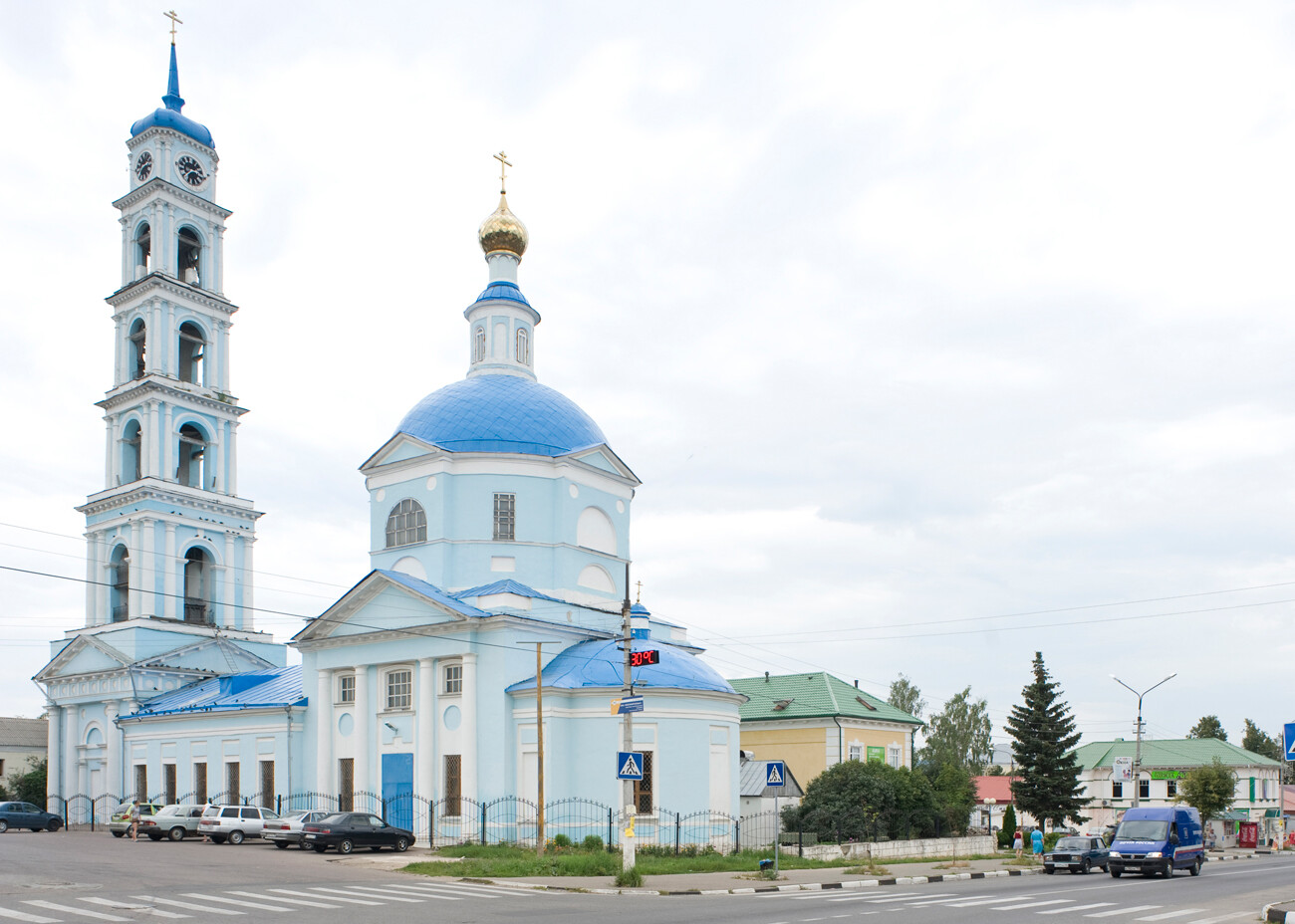
Kashira. Church of the Presentation, southeast view. Built in a simplified Neoclassical style in 1802-17. August 4, 2012
William BrumfieldAt the beginning of the 20th century, Russian chemist and photographer Sergey Prokudin-Gorsky developed a complex process for vivid, detailed color photography. His vision of photography as a form of education and enlightenment was demonstrated with special clarity through his photographs of architectural monuments in historic sites throughout the Russian heartland.
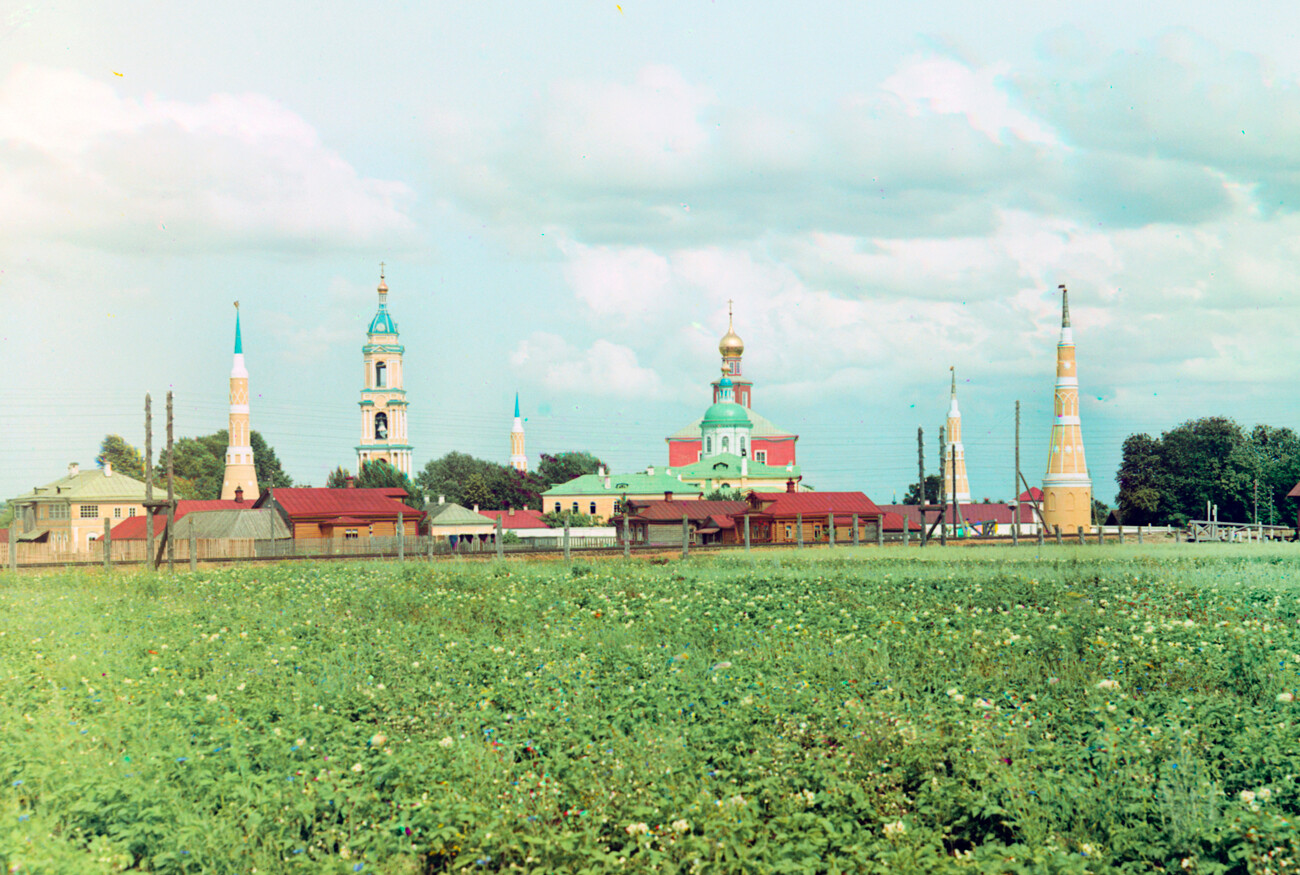
Near Kolomna. Old Golutvin Epiphany Monastery, west view. From left: northwest corner tower, bell tower, NE corner tower, Epiphany Cathedral & St. Sergius Church, SE corner tower, SW corner tower. Summer 1912
Sergey Prokudin-GorskyAmong the sites photographed by Prokudin-Gorsky in 1912 was the Epiphany-Golutvin Monastery (known after 1800 as Old Golutvin Monastery) near Kolomna, some 115 km south of Moscow. The Golutvin Monastery’s walls and fanciful towers suggest an imaginary fortress with towers in the Gothic Revival style that spread throughout central Russia during the reign of Catherine the Great.
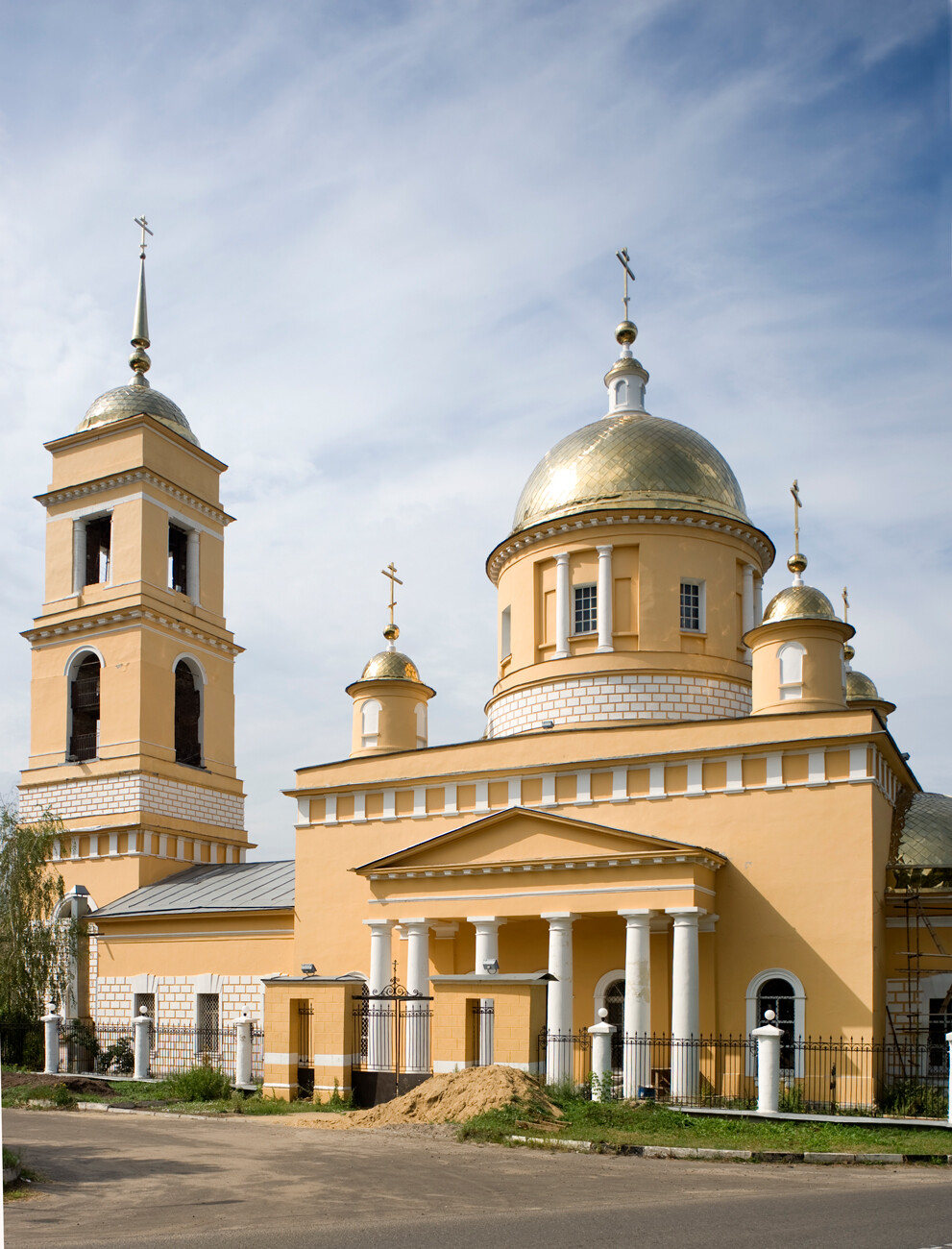
Kashira. Cathedral of the Dormition, south view. Built in 1829-42 in a late Neoclassial style promulgated by the architect Apollon Grigorev. August 4, 2012
William BrumfieldIn addition to Kolomna, the southern part of Moscow Region encompasses several other historic settlements sharing a history marked by turbulence and invasion. Among them is Kashira (population around 45,000), now located on the high right bank of the Oka River, 100 km southeast of Moscow.
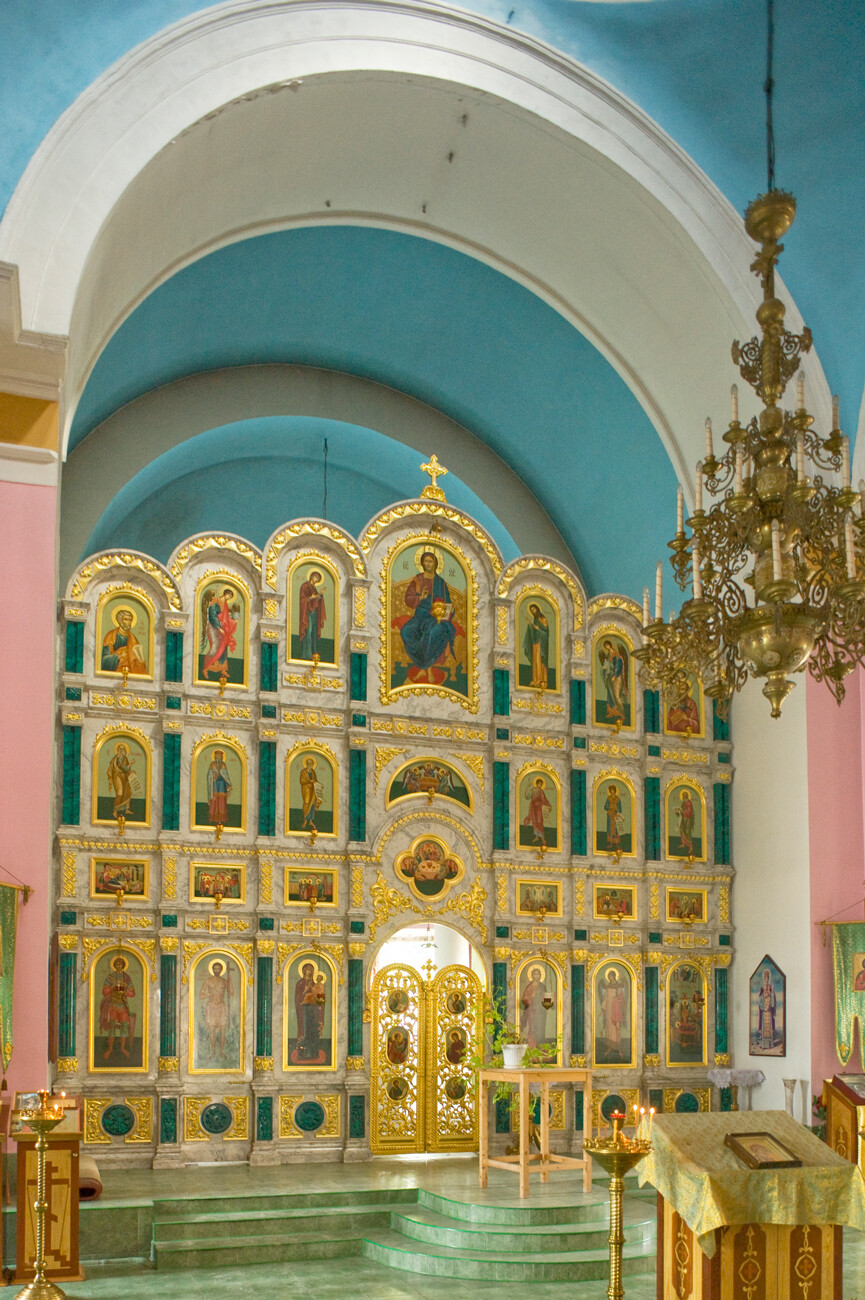
Cathedral of the Dormition. Interior, view east toward new icon screen. August 4, 2012
William BrumfieldWith a population of roughly 6,000 at the beginning of the 20th century, Kashira was a typical provincial town whose architectural landmarks were primarily Orthodox churches. Because of Kashira’s role in the development of the Soviet electric power industry (see further below), its pre-revolutionary buildings suffered from neglect and, in the case of churches, vandalism. The surviving historical ensemble is now being preserved and churches are undergoing restoration with some success.
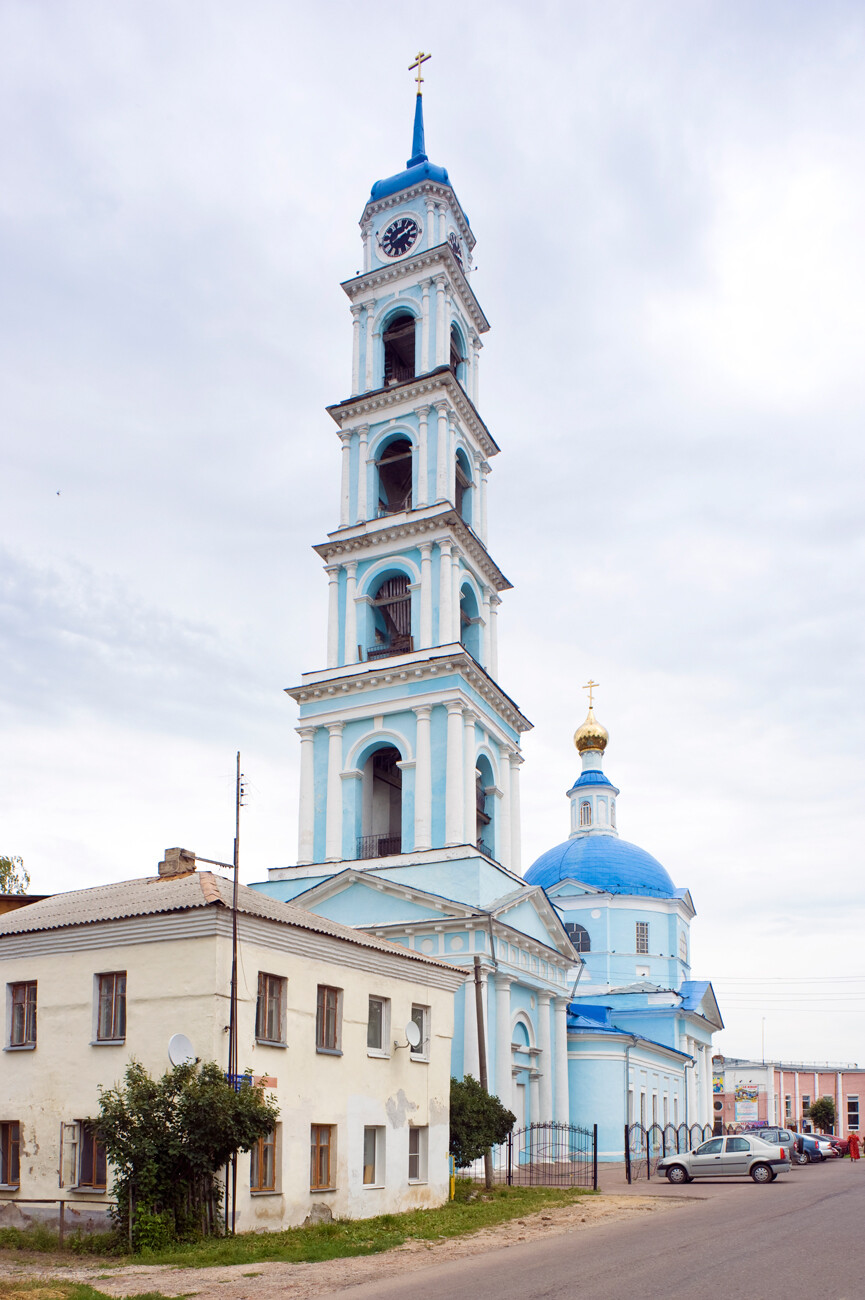
Church of the Presentation with 6-tiered bell tower. Southwest view along Engels Street. August 4, 2012
William BrumfieldDuring the late medieval period, towns to the south of Moscow served a defensive purpose, since Muscovy was vulnerable to attack from the southern steppes. Kashira was one of those defensive outposts and few, if any, paid a heavier price for the role.
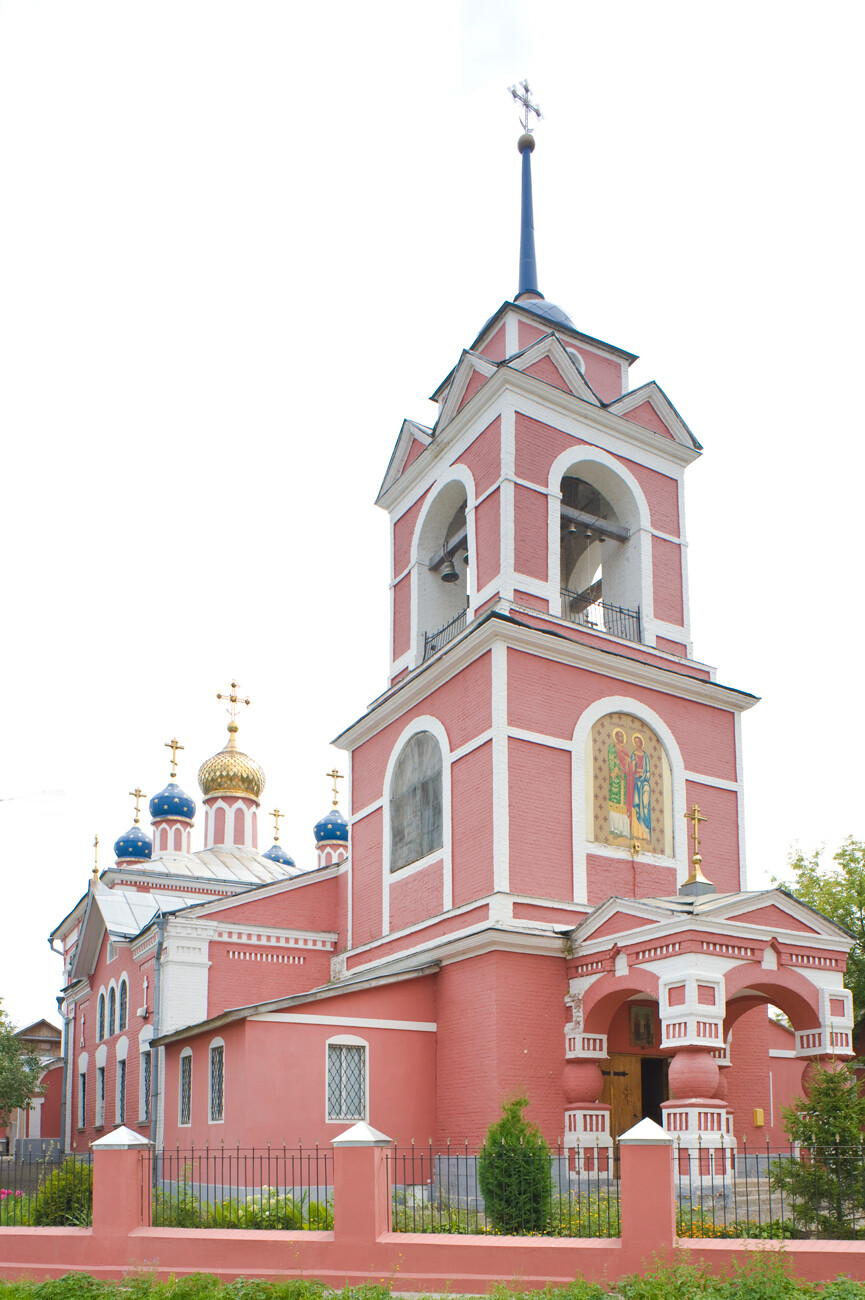
Church of Sts. Florus & Laurus, northwest view. Originally built in 1776 and rebuilt in phases from 1840s to 1869 when the bell tower was completed. August 4, 2012
William BrumfieldThe first documented reference to the settlement was in the 1350s as part of the domains of Prince Ivan II, who deeded it to his son Dmitry – renowned for his major victory in 1380 over Khan Mamai of the Golden Horde. At that time, Kashira was located on the left (north) bank of the Oka River, near the small Kashirka River.
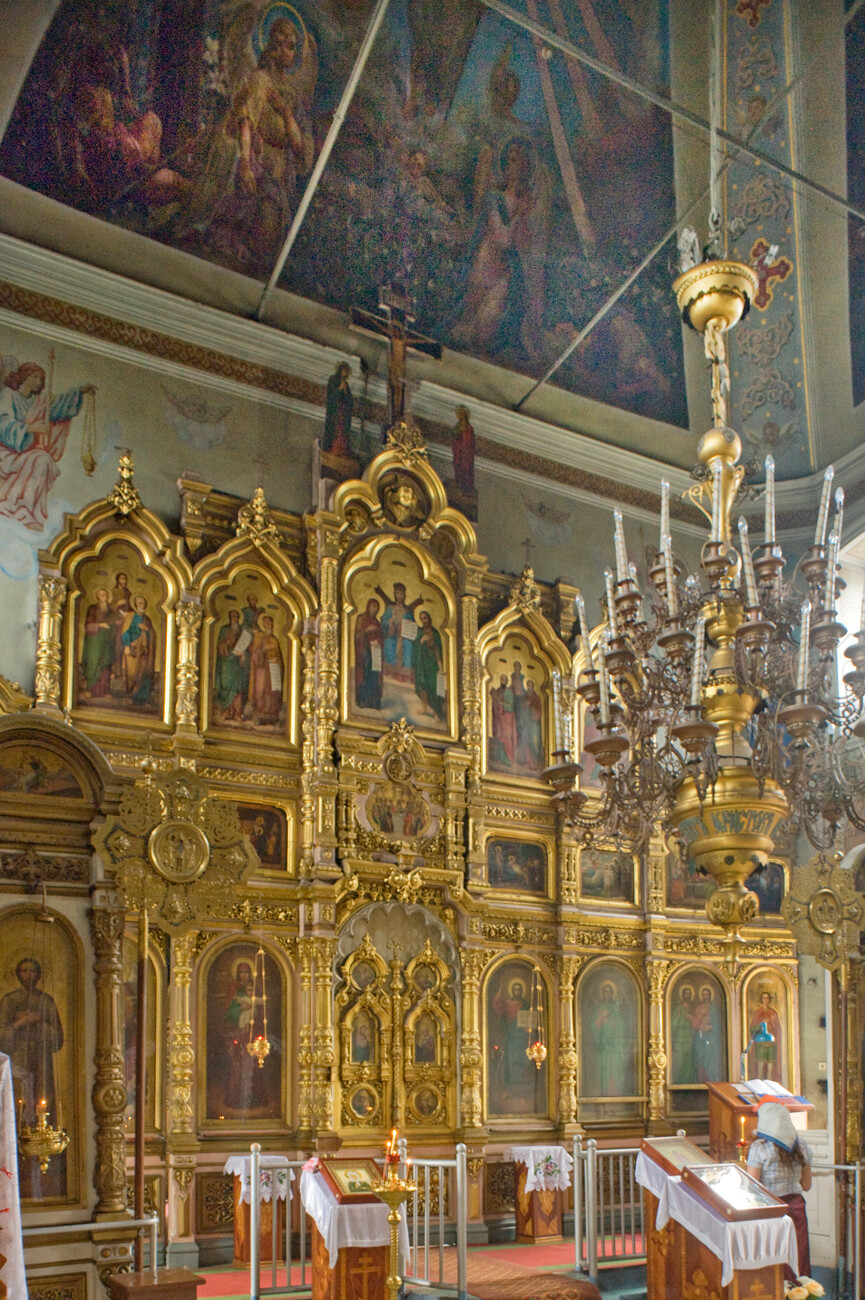
Church of Sts. Florus & Laurus. Interior, view east toward icon screen renovated in 1891. This church remained open throughout the Soviet period. August 4, 2012
William BrumfieldIn 1480, during the reign of Ivan III, Kashira played a part in the formal end of Tatar dominance over the Russian lands. For a brief time at the turn of the 16th century, it provided income to Tatar princes who had transferred their loyalty to Moscow. In 1498, the town’s spiritual significance increased with the establishment nearby of the Trinity-Belopesotsky Monastery.
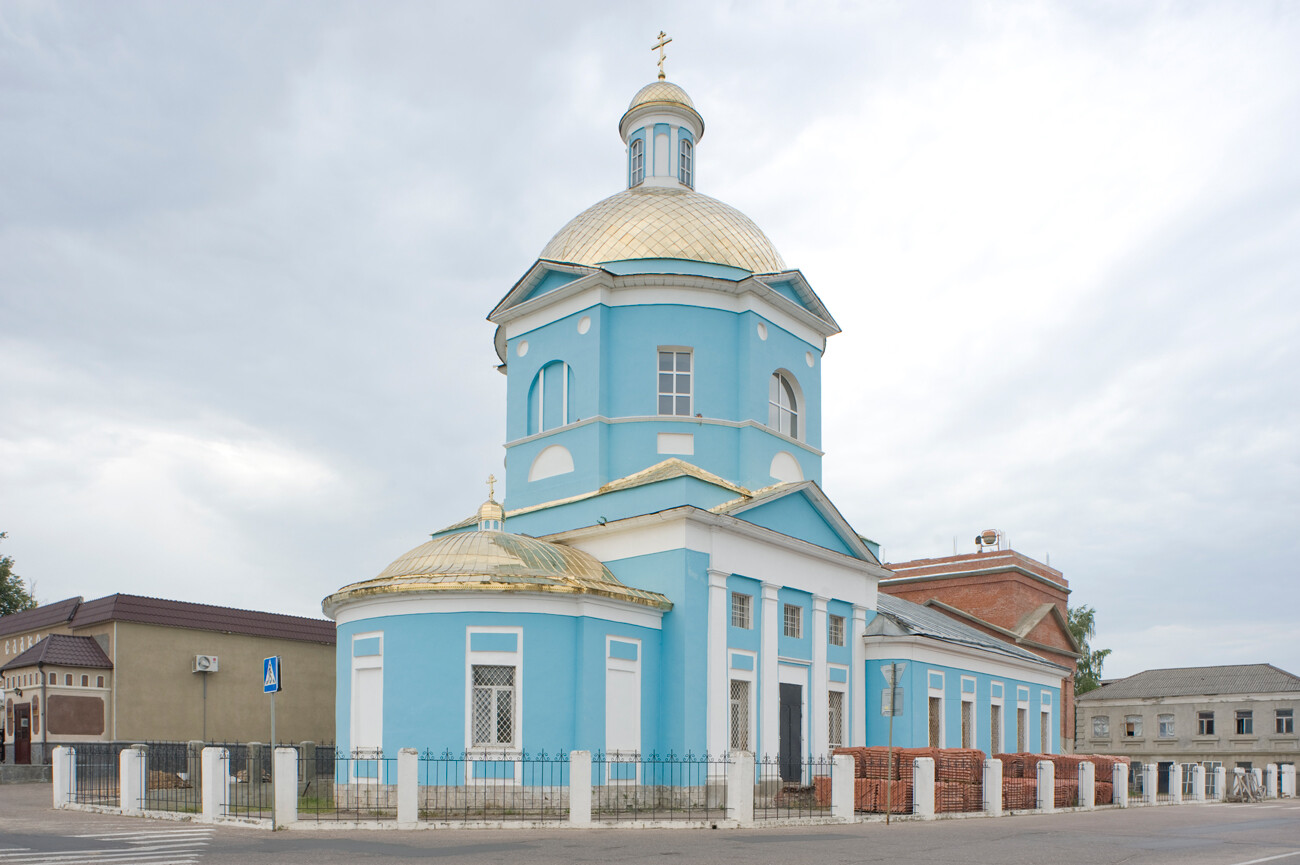
Church of the Ascension, northeast view. Built in a simplified neoclassical style from 1826 to 1840s. This view shows early phase of rebuilding the mid-19th century bell tower, razed in the Soviet period and completed in 2016. August 4, 2012
William BrumfieldA new threat from the south appeared in the early 16th century, when Crimean Tatars launched numerous attacks on Muscovy. Heavily fortified in 1531, Kashira was frequently raided throughout the 16th century.
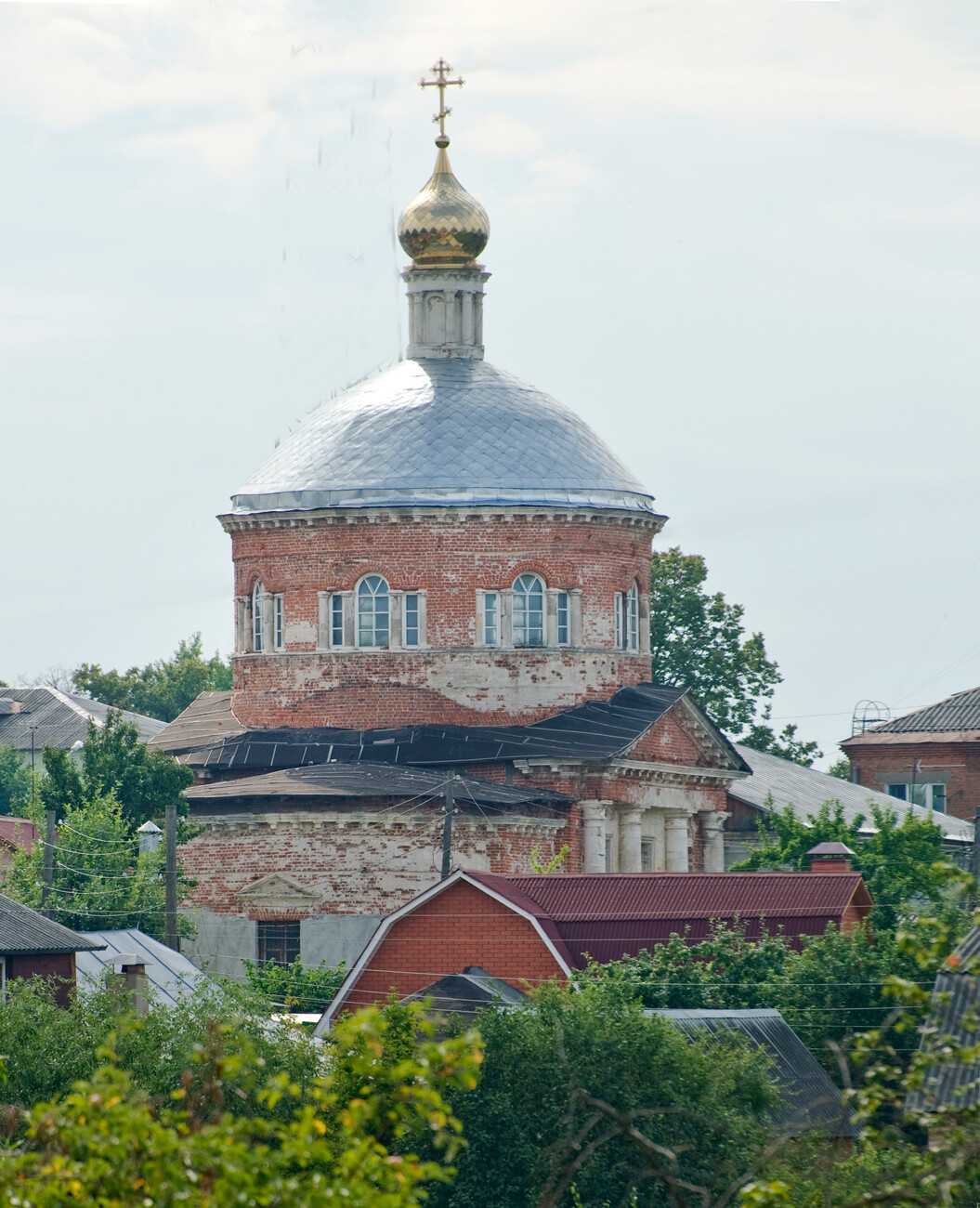
Church of the Trinity, northeast view. Designed in a late neoclassical style and built in phases during the 19th century. Seen here as a picturesque ruin before its restoration. August 4, 2012
William BrumfieldThe most devastating attack occurred in 1571, when the Crimean khan Devlet-Girei I (1512-1577) managed to deceive Ivan the Terrible’s forces and reached the outskirts of Moscow in May. Although he did not take the Kremlin, the Crimean khan set fire to the southern parts of Moscow, built primarily of wood. Hot, windy conditions led to a catastrophic firestorm that destroyed much of the city and caused thousands of deaths. Kashira was among the many lesser towns also sacked during this invasion.
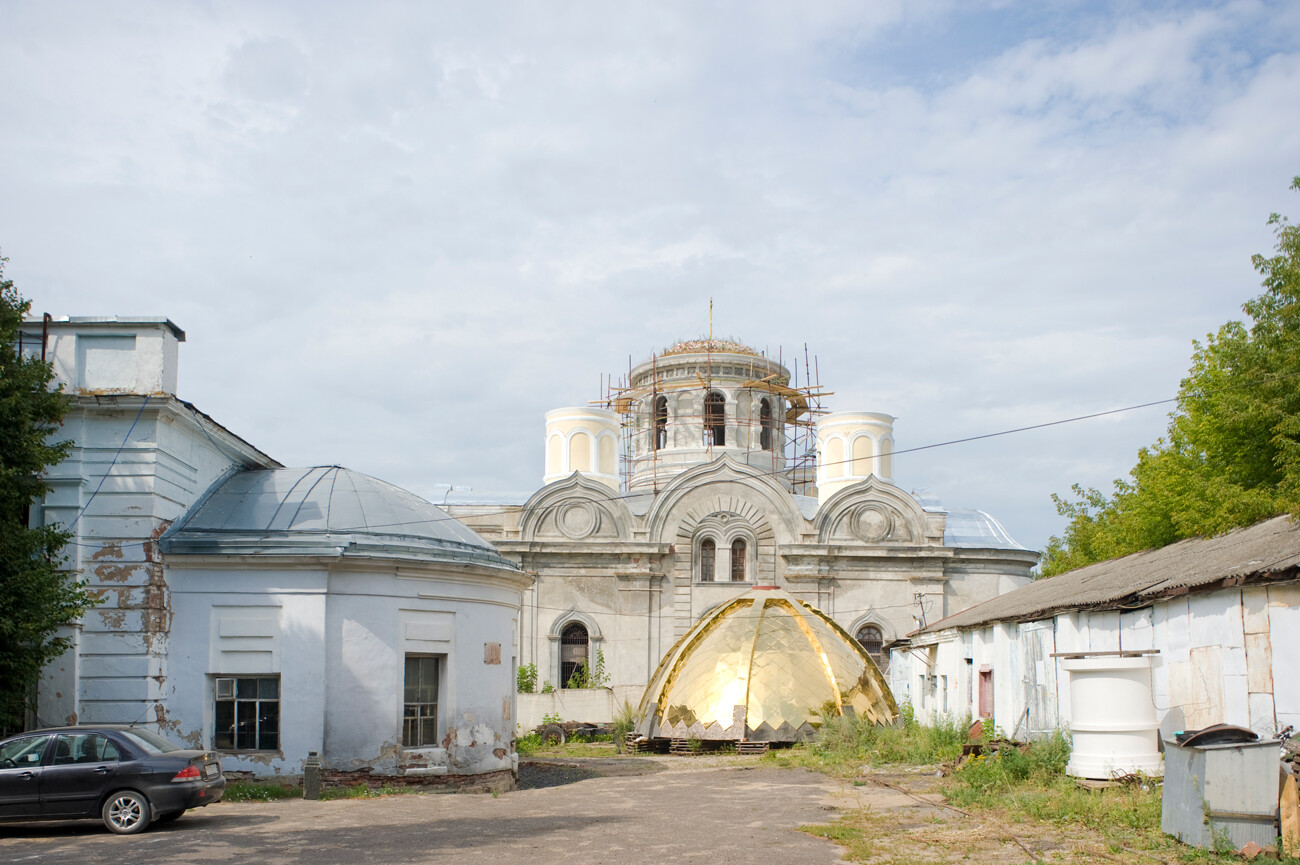
St. Nicetas Kashira Convent, Transfiguration Cathedral in process of restoration with new cupola (foreground) ready to be lifted in place. August 4, 2012
William BrumfieldThe 1571 disaster revealed the failure of Ivan’s ‘oprichnina’ reign of terror (1565-1572), especially since the tsar himself had fled Moscow. With the abolishment of the ‘oprichnina’ division of the country shortly thereafter, Russian forces were prepared when Devlet-Girei returned in 1572 with Ottoman support. After his success the preceding year, the Crimean leader intended the general subjugation of Muscovy, but his forces of over 100,000 were routed and destroyed near the village of Molodi to the north of Kashira. After this, the Crimean Tatars never again launched an attack on Moscow.
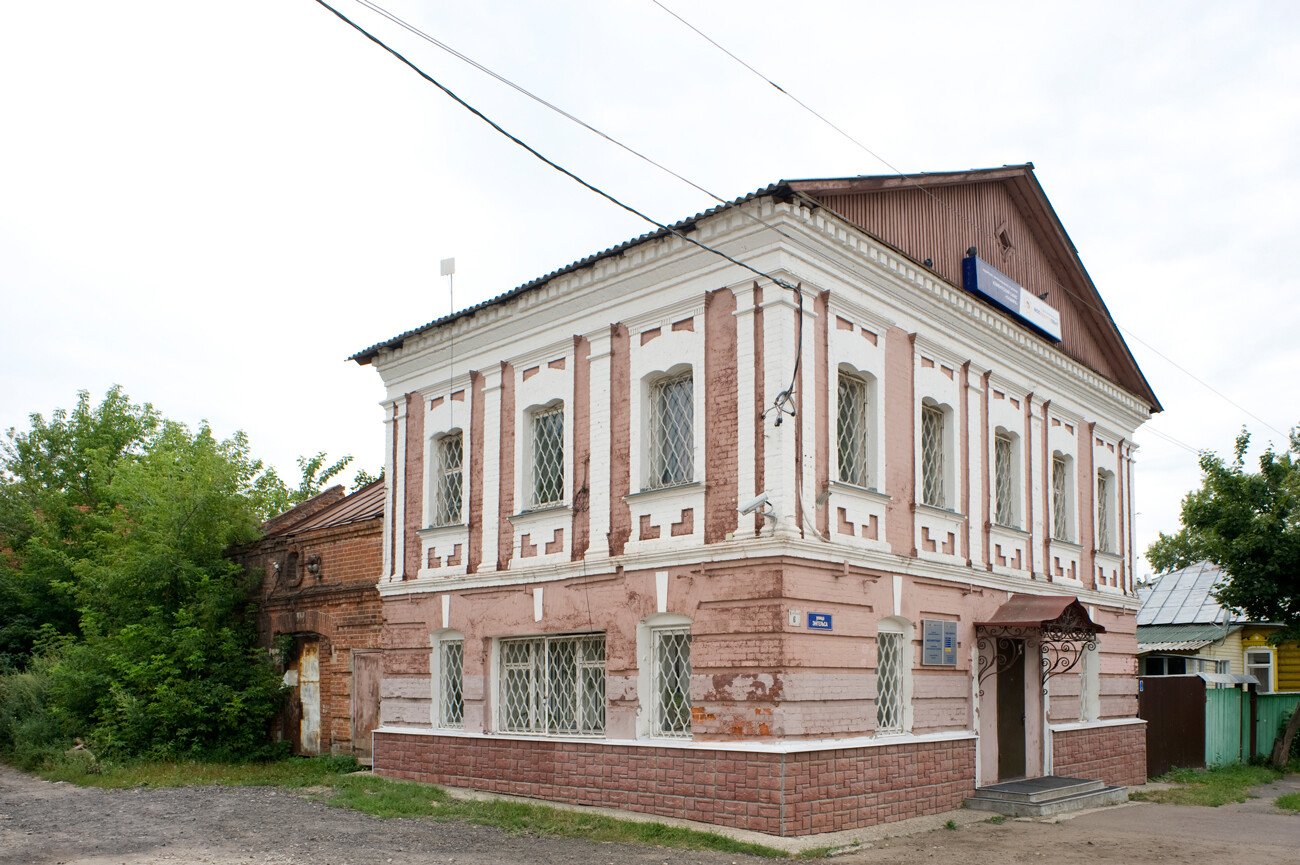
Brick house, Engels Street 9. Built in 18th-century provincial baroque style. August 4, 2012
William BrumfieldThe great Russian victory at Molodi did little, however, to revive the fortunes of Kashira, beset by plague and then famine, in 1601-1602. After the death of Tsar Boris Godunov in 1605, Kashira, like other Russian towns, was caught in the chaos of a dynastic interregnum known as the ‘Time of Troubles’.
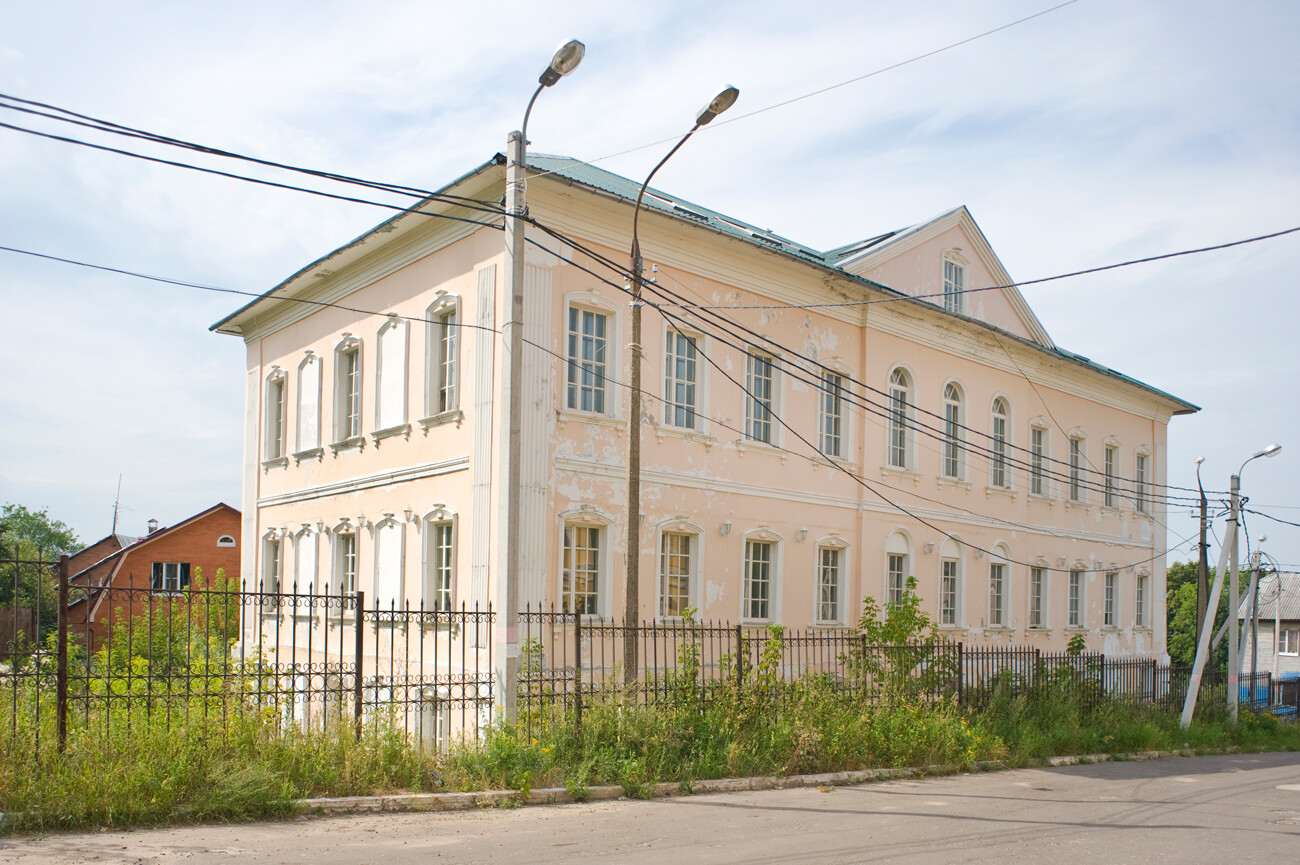
Early 19th-century regional administrative offices, Volodarsky Square 5. August 4, 2012
William BrumfieldThe enthronement of Tsar Romanov in 1613 did not end Russia’s troubles. In 1618, Cossack forces led by Hetman Peter Sagaidachny, with the encouragement of a Polish pretender to the Muscovite throne (Władysław IV Waza), sacked many Russian towns, including Kashira.
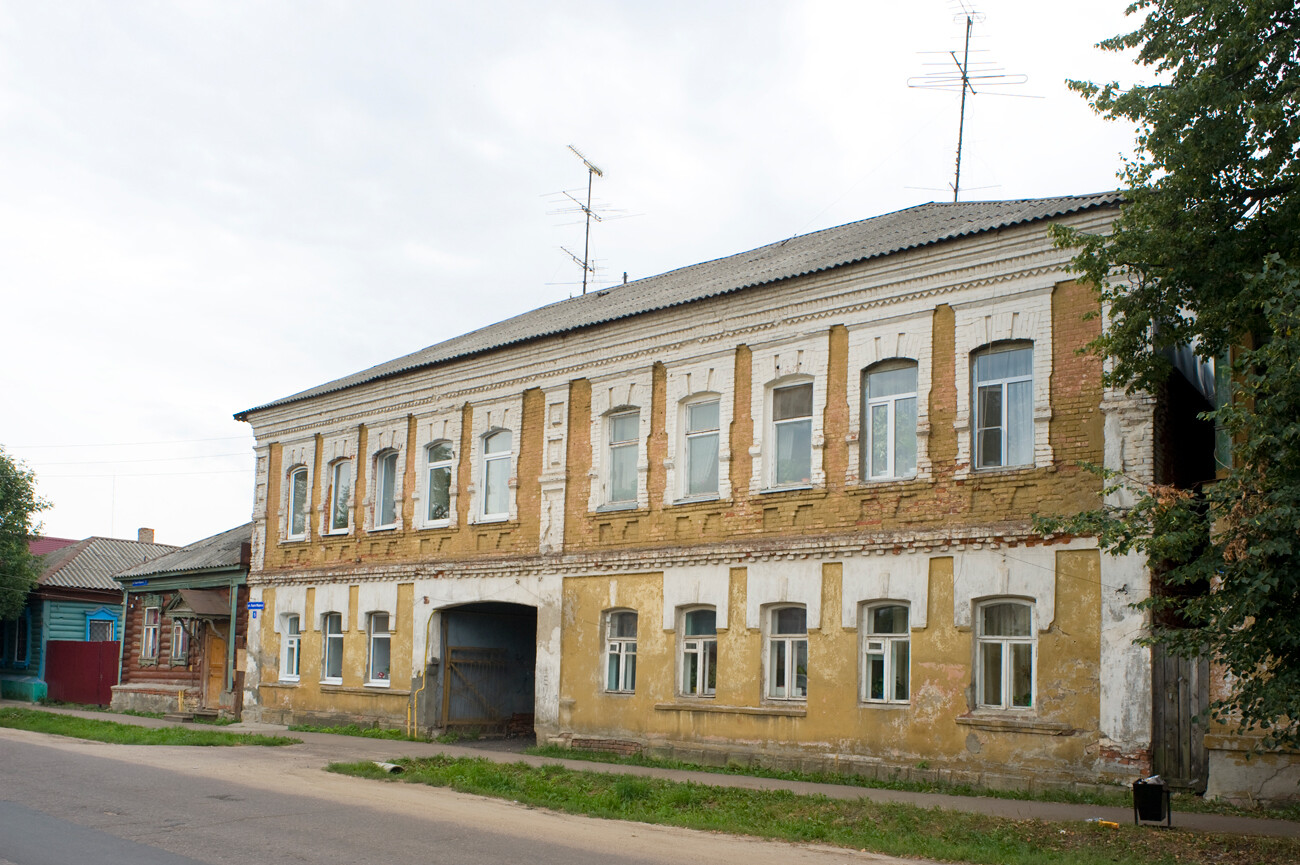
Late 19th-century brick commercial building, Marx Street 5. August 4, 2012
William BrumfieldIn 1620, the desolate remains of Kashira were abandoned and the town was rebuilt on the opposite bank of the Oka, with a strong earthen fortress of European design. That fortress was never attacked and, by the 18th century, Kashira had become a regional trading point for grain and cattle. In 1779, it gained a new plan (existing to this day) as part of Catherine the Great’s reform of provincial centers.
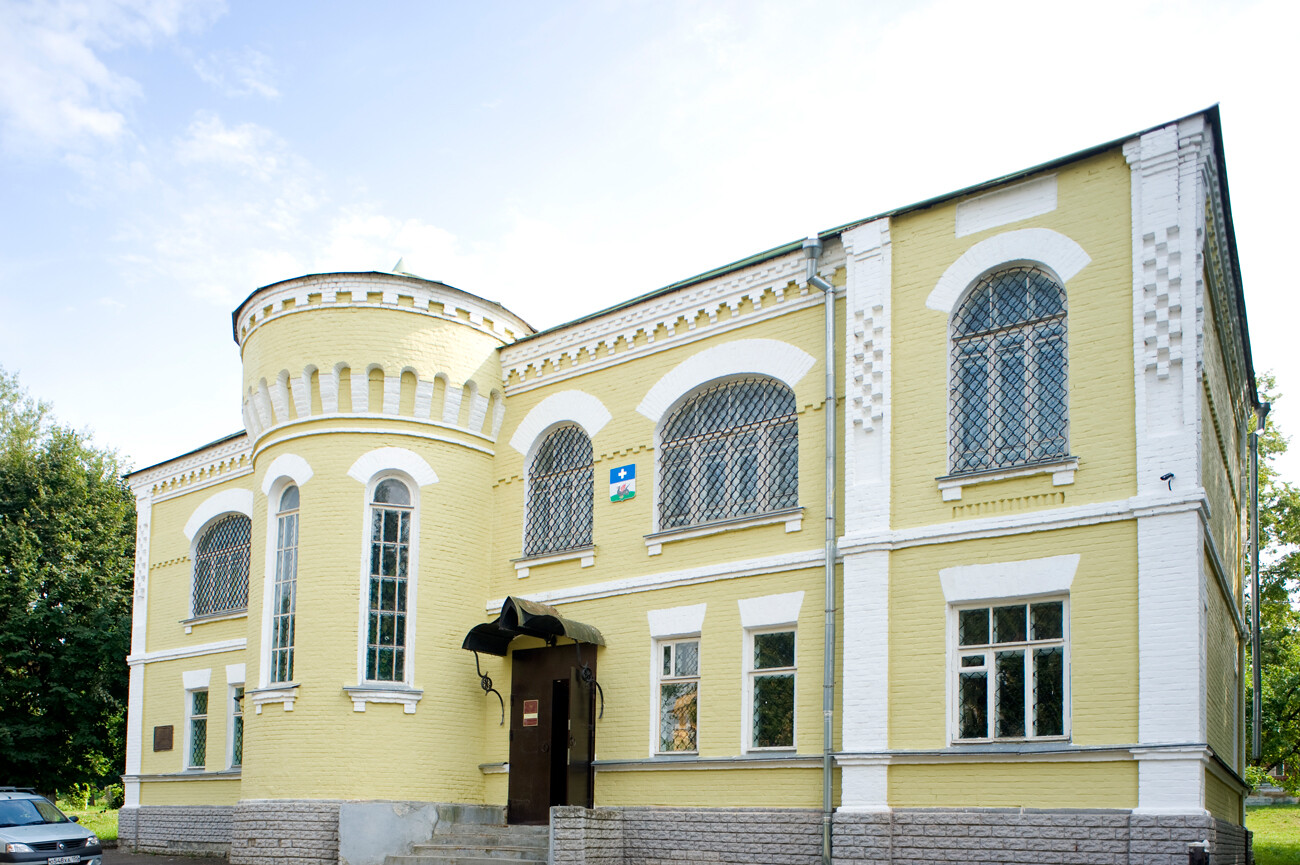
City School, Soviet Street 46. Built 1911 in picturesque neo-Romanesque style. August 4, 2012
William BrumfieldWith Kashira’s turbulent history, almost no buildings have survived from before the beginning of the 19th century. An exception is the 1776 Church of Sts. Florus and Laurus (early Christian martyrs), which has a well preserved interior from the 19th century.
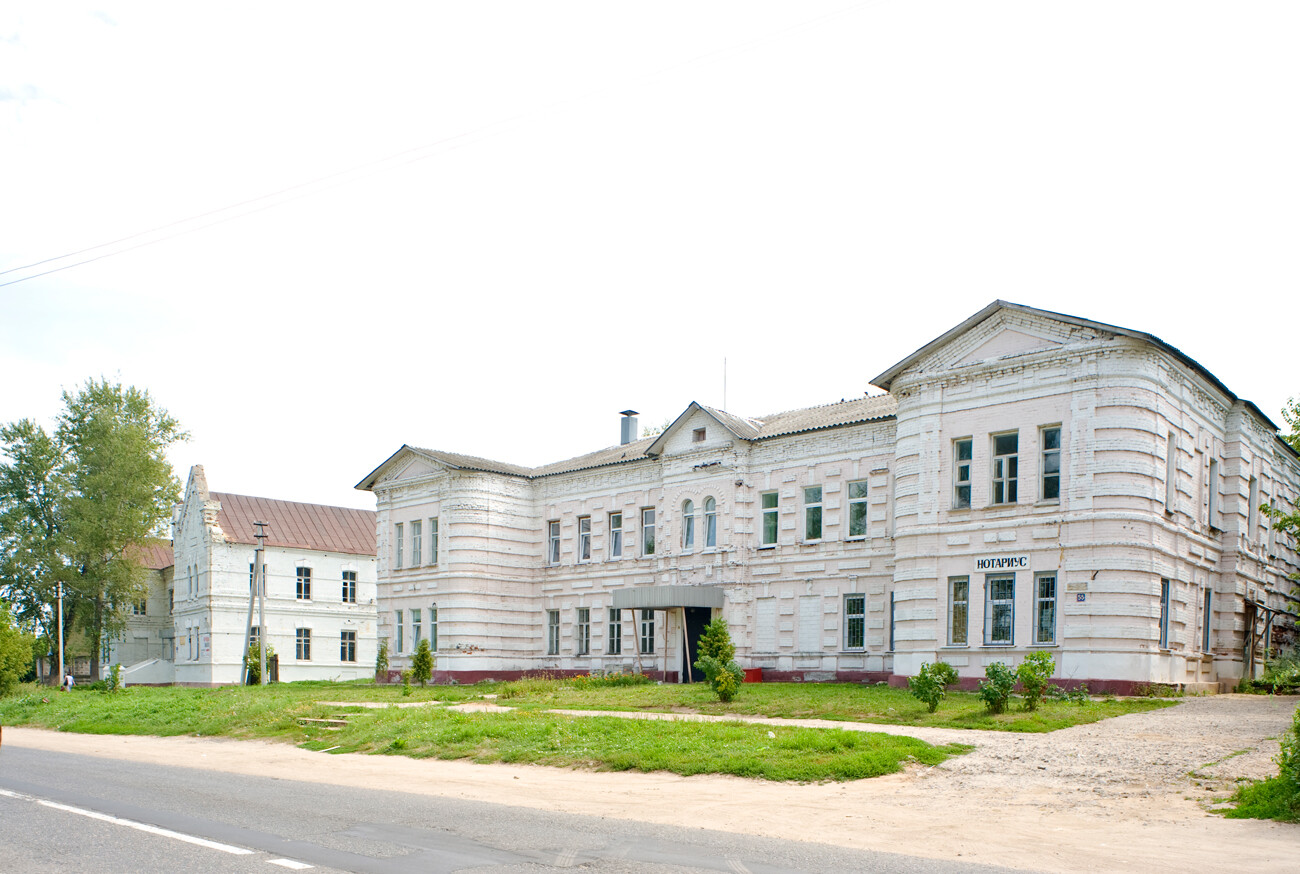
Early 20th-century school buildings in decorative brick style, Soviet Street 55. August 4, 2012
William BrumfieldThe neoclassical spirit of Catherine’s reign was transferred to a number of churches during the early 19th century, including the main Cathedral of the Dormition, begun in the late 1820s and completed in 1842. Desecrated during the Soviet period, it has now been handsomely restored.
Other notable monuments include the Church of the Presentation (1802-17), whose soaring bell tower dominates the center of town. Its interior is being restored, as is the nearby Church of the Ascension (1826-42).
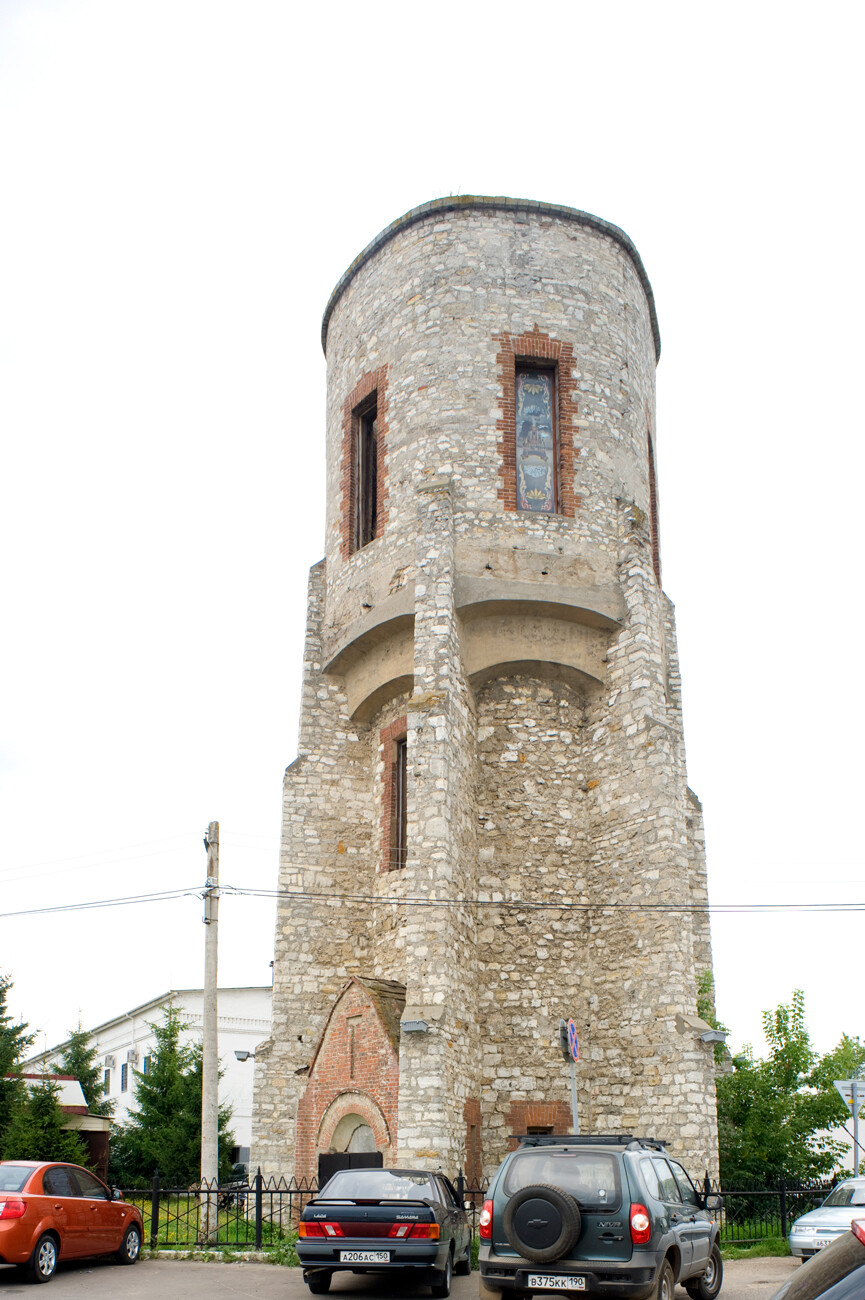
City water tower, Soviet Street. Masonry structure built in early 20th century in neo-Romanesque style. August 4, 2012
William BrumfieldI was also able to photograph the process of restoring the Transfiguration Cathedral at the St. Nicetas Kashira Convent, formally established in 1884. Built in 1889-94, the cathedral is a late example of the Russo-Byzantine style promulgated during the reign of Nicholas I in the middle third of the 19th century. Closed in 1922, the Convent was officially reopened in 2019.
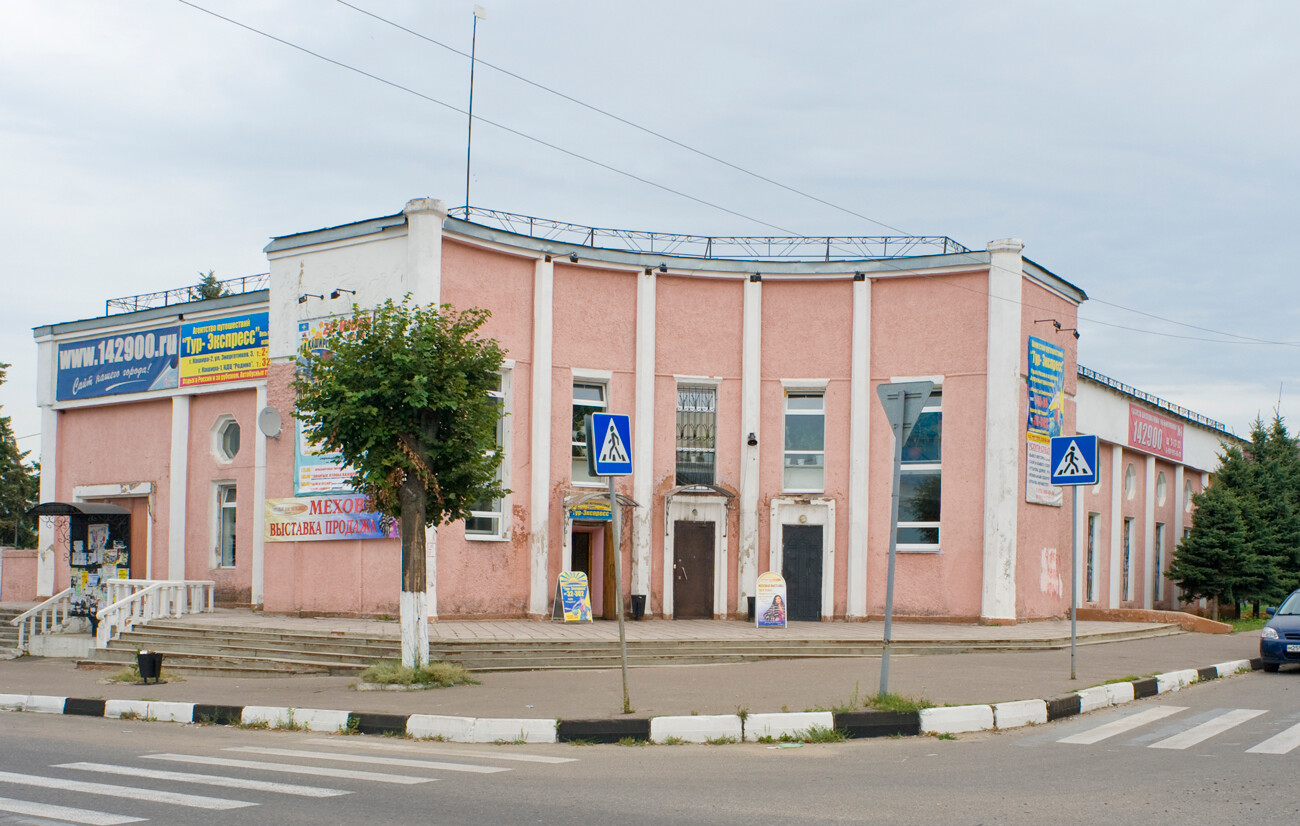
"Rodina" Cinema, Marx Street 21. Built in 1936, a rare example of Constructivist-influenced architecture. August 4, 2012
William BrumfieldThe center of Kashira is graced by an early 20th-century water tower, built in a delightfully idiosyncratic imitation of a medieval castle. Other buildings in the modest downtown include examples of Soviet architecture, from a constructivist cinema and club to a neoclassical revival state bank. Part of the charm of central Kashira is its accessible scale, which includes 19th-century houses.
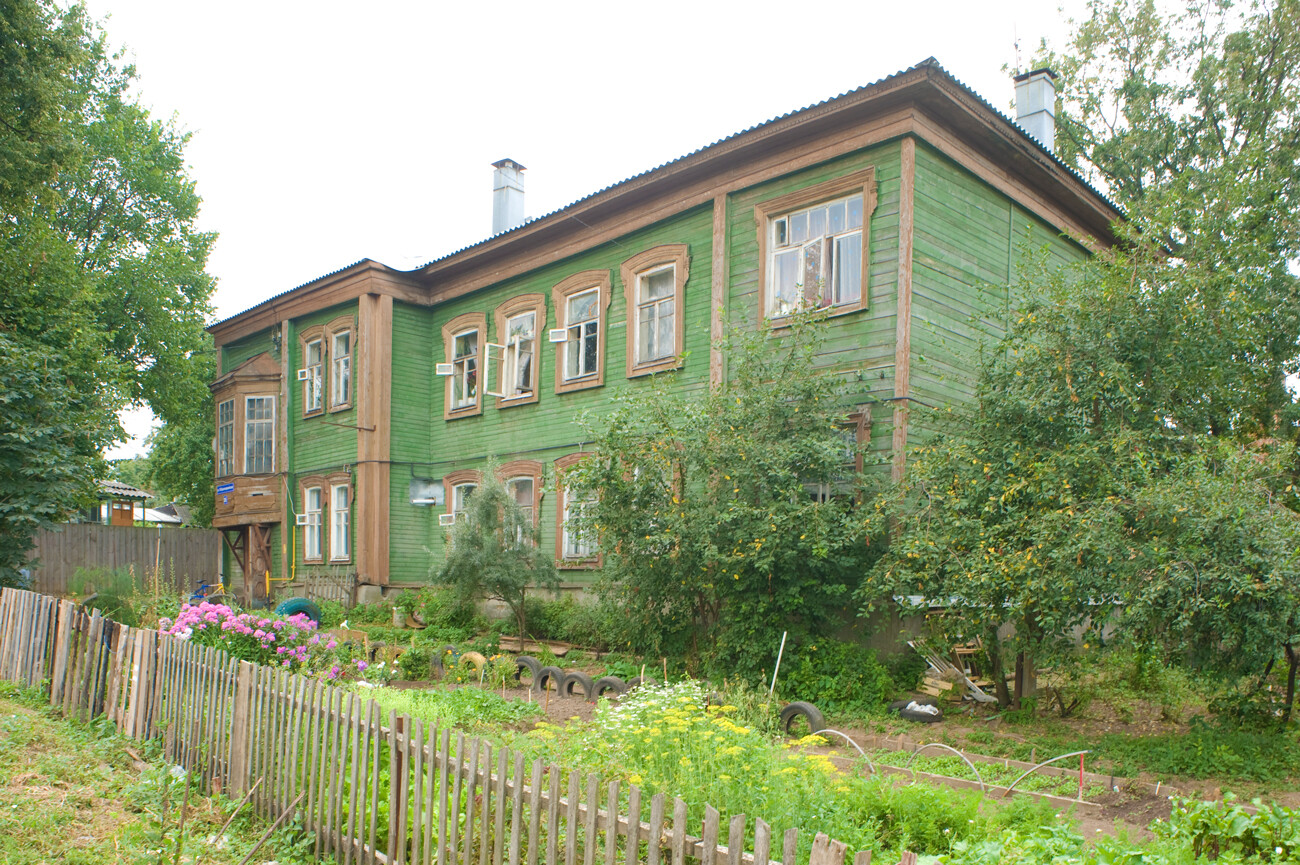
Early 20th-century wooden apartment building, Small Red Army Street 26. Note vegetable garden in foreground. August 4, 2012
William BrumfieldThe most important historic ensemble in the vicinity of Kashira is the Trinity-Belopesotsky Monastery, founded toward the end of the 15th century by a monk named Vladimir at a site known as ‘Belye Peski’ (‘White Sands’) on the left bank of the Oka River. At that time the site was near the original location of Kashira, and the walled monastery served as one of the fortifications protecting Muscovy’s southern border from Crimean Tatar raids during the 16th century.
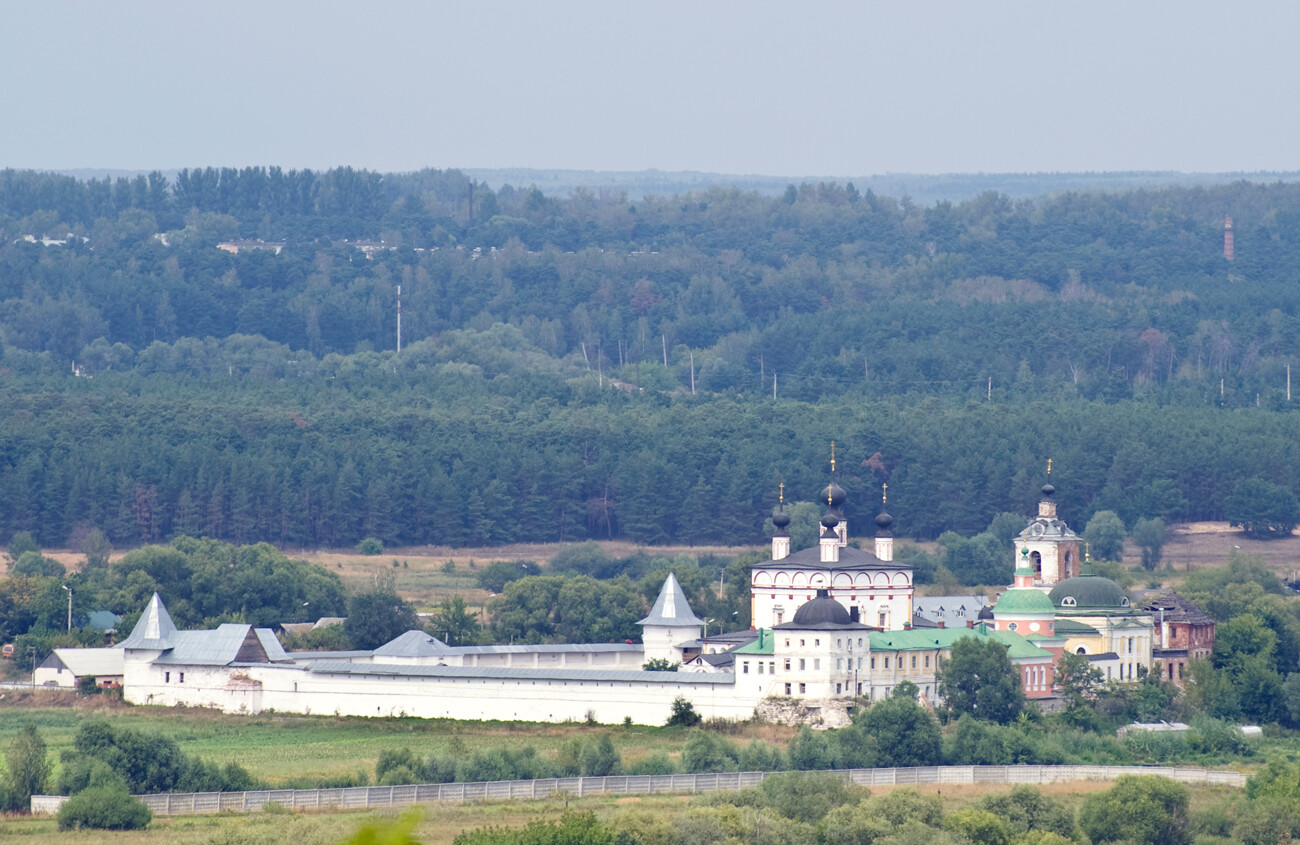
Stupino. View from Kashira across Oka River toward "White Sands" & Trinity Belopesotsky Monastery (now convent). August 4, 2012
William BrumfieldBy the second half of the 16th century, most of the monastic structures were of brick, but only fragments have survived from that time. Among them is the lower part of the Church of St. Nicholas, which would subsequently serve as the base for a bell tower erected in 1794.
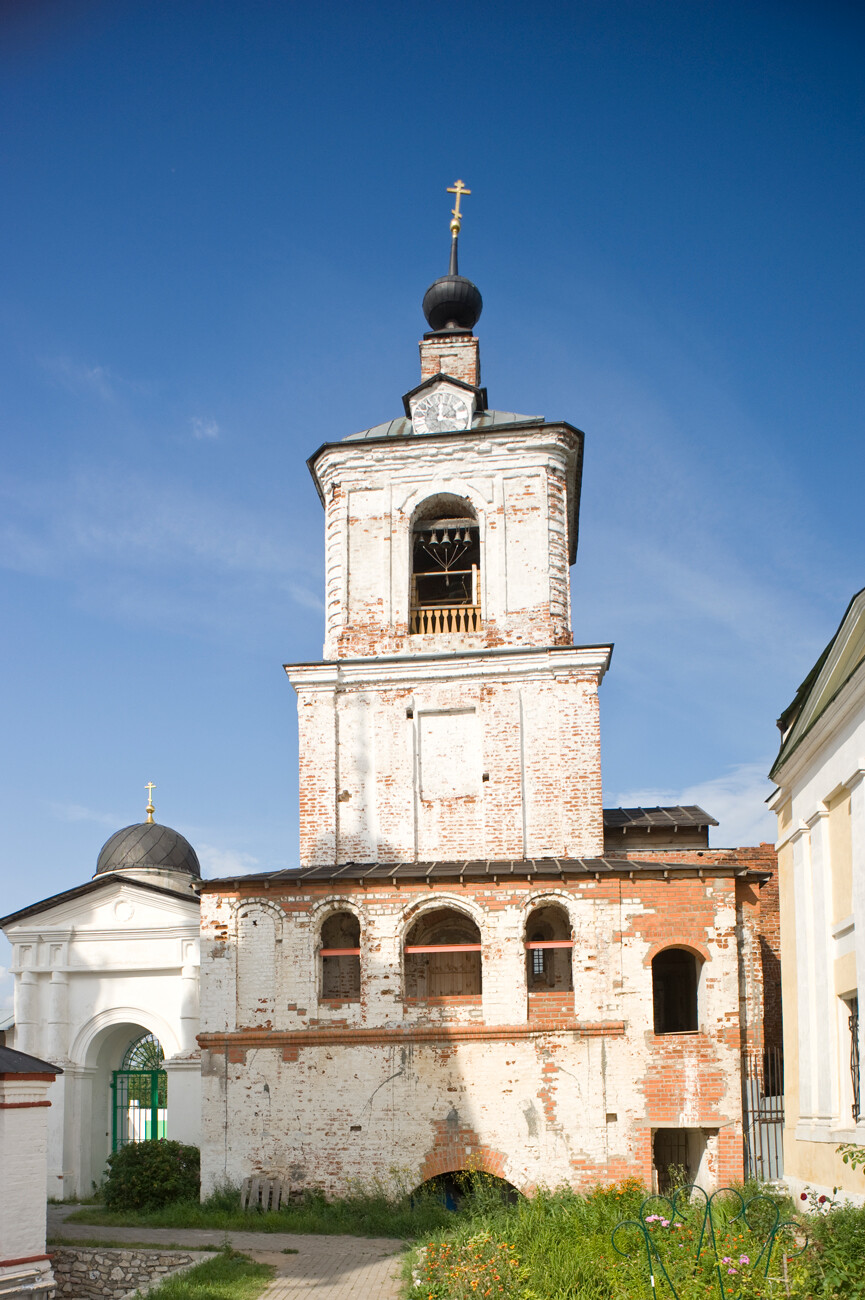
Trinity Belopesotsky Monastery, Cathedral of the Trinity, northwest view. August 4, 2012
William BrumfieldThe Trinity Monastery was largely rebuilt beginning in the 17th century as the area recovered from the Time of Troubles. The largest structure is the brightly decorated Cathedral of the Trinity, whose date of construction is tentatively dated to the late 17th century.
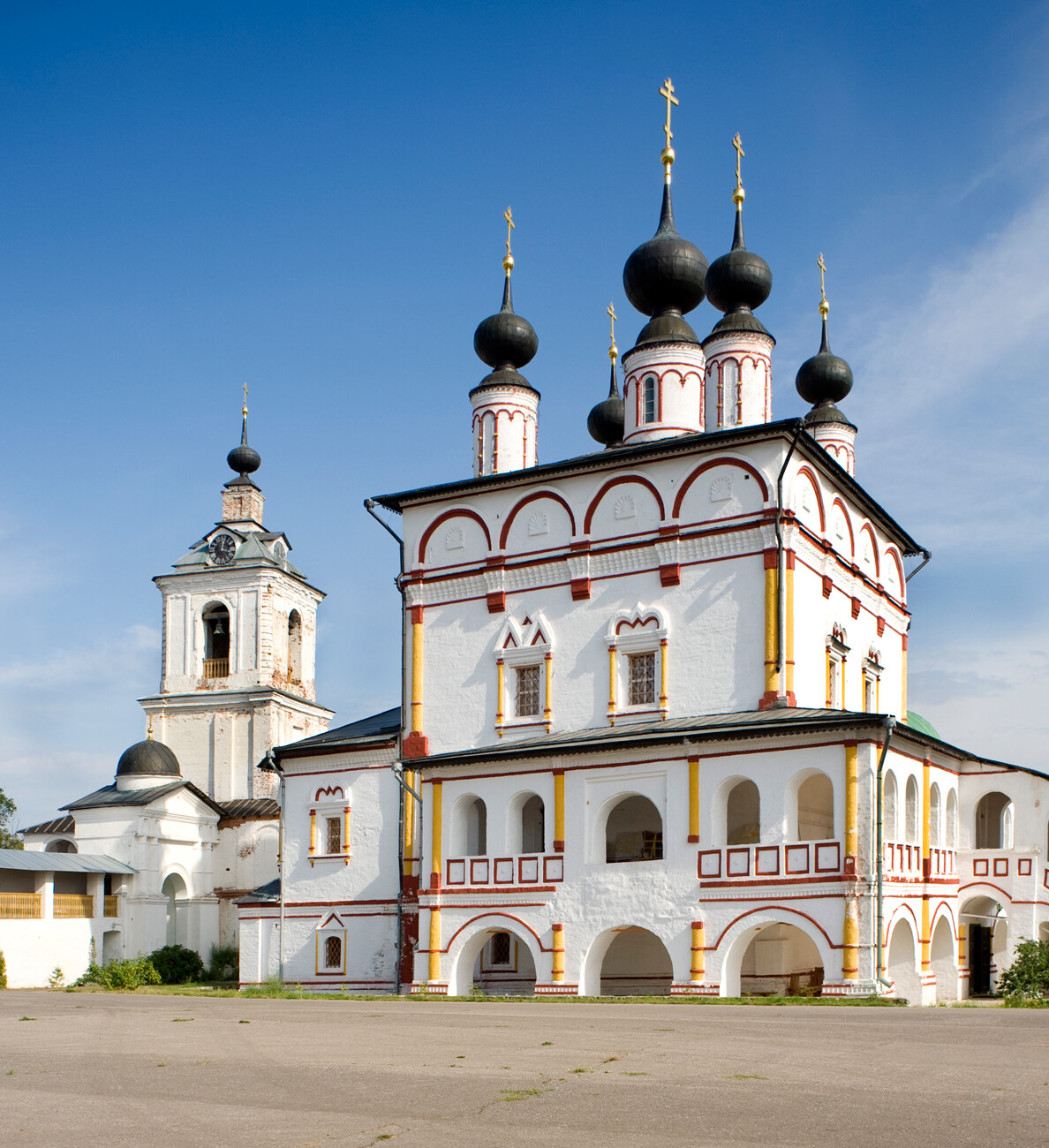
Trinity Belopesotsky Monastery, Church of St. Nicholas with bell tower above, west view. August 4, 2012
William BrumfieldOther churches, cloisters, and wall towers were added throughout the 19th century. Closed by the Bolsheviks in 1918, it was reconsecrated in 1993 as a convent near the industrial town of Stupino,
Despite its rail and river links, Kashira remained a minor district town into the beginning of the 20th century. That changed dramatically in 1919, when Kashira was chosen as the location for a showcase power plant that would launch the Soviet campaign to bring electricity throughout the country. Completed in 1922, the first phase used nearby sources of peat and subsequently soft brown coal throughout the 1930s.
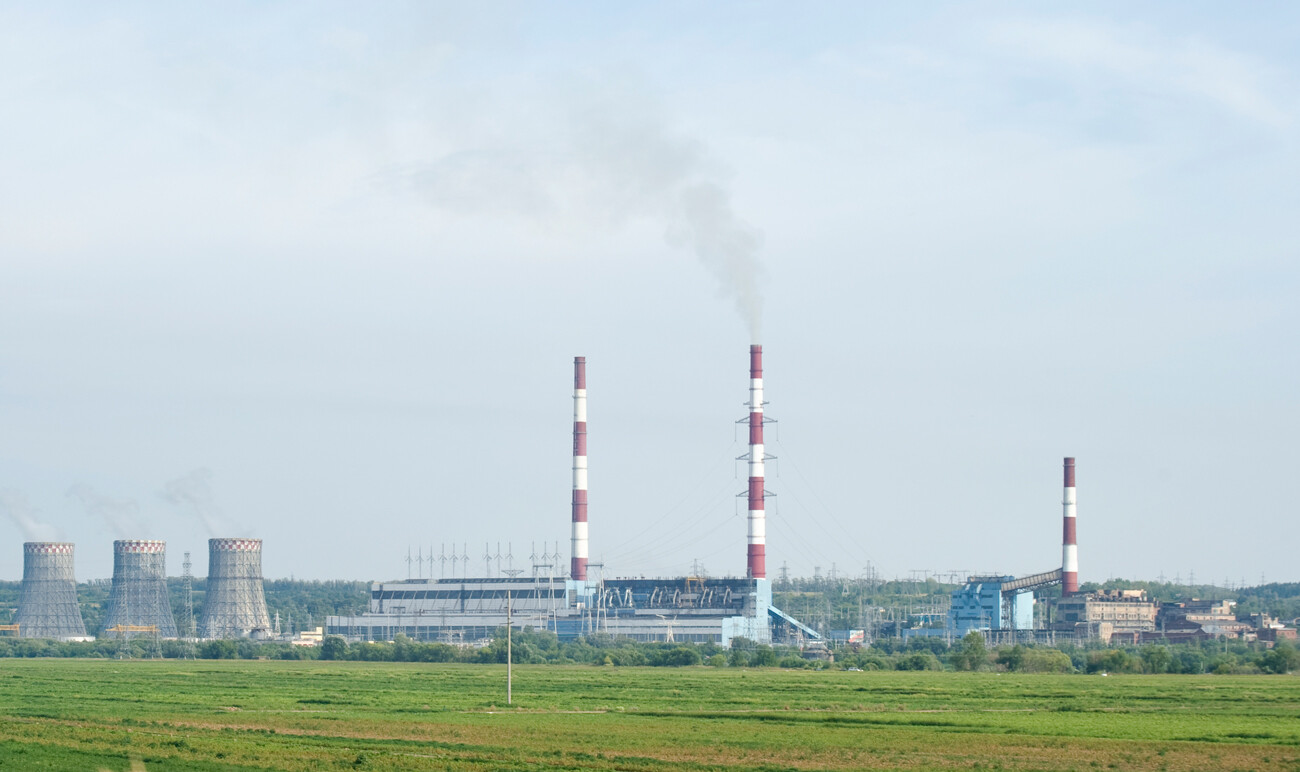
Kashira Electric Power Station, view from left bank of Oka River. August 4, 2012
William BrumfieldAlthough Hanz Guderian’s tank forces reached Kashira in the fall of 1941, the Wehrmacht was decisively pushed back in December 1941 as part of the Soviet victory in the Battle of Moscow. Despite the evacuation of much equipment, power was partially restored already in January 1942 and eventually supplied a major factory for the production of airplane propellers.
The Kashira power plant has had a complicated history in this century, and there are plans for its extensive renovation. The sprawling enterprise is visible along the Oka River when approaching the town from Moscow.
In the early 20th century, Russian photographer Sergey Prokudin-Gorsky developed a complex process for color photography. Between 1903 and 1916, he traveled through the Russian Empire and took over 2,000 photographs with the process, which involved three exposures on a glass plate. In August 1918, he left Russia and ultimately resettled in France, where he was reunited with a large part of his collection of glass negatives, as well as 13 albums of contact prints. After his death in Paris in 1944, his heirs sold the collection to the Library of Congress. In the early 21st century, the Library digitized the Prokudin-Gorsky Collection and made it freely available to the global public. A few Russian websites now have versions of the collection. In 1986, architectural historian and photographer William Brumfield organized the first exhibit of Prokudin-Gorsky photographs at the Library of Congress. Over a period of work in Russia beginning in 1970, Brumfield has photographed most of the sites visited by Prokudin-Gorsky. This series of articles juxtaposes Prokudin-Gorsky’s views of architectural monuments with photographs taken by Brumfield decades later.
If using any of Russia Beyond's content, partly or in full, always provide an active hyperlink to the original material.
Subscribe
to our newsletter!
Get the week's best stories straight to your inbox